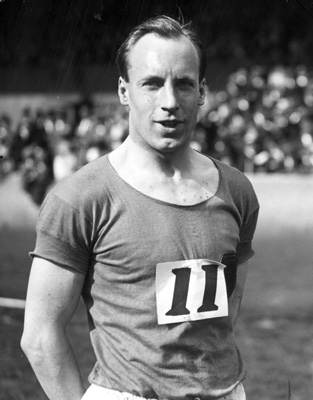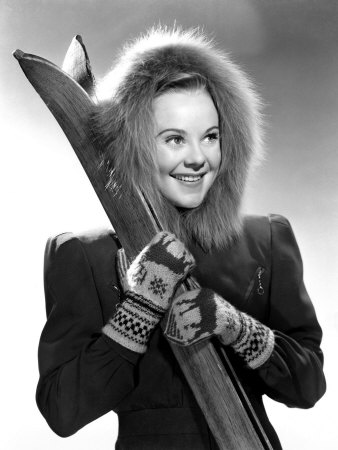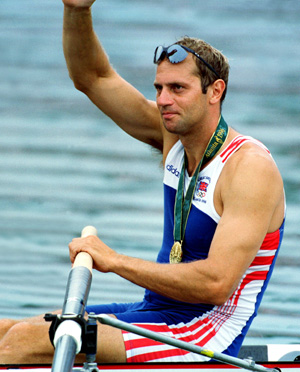1. Stockholm, 1912
Jim Thorpe was an American athlete of Native American descent. He was a
runner. He competed
in the Olympic Games in Stockholm, Sweden in 1912.
He won two gold medals, one in the pentathlon and one in the decathlon.
King Gustav V of Sweden gave
Jim Thorpe the gold medals. He said that Jim Thorpe was ‘the greatest
athlete in the world’.
However, there was a problem. Jim Thorpe wasn’t an amateur athlete.
Before the Stockholm Olympics,
Jim played baseball for $25 a week. He didn’t play because he wanted
money. He played because he
loved baseball.
However, the Olympic Committee took away his gold medals. Jim Thorpe
didn’t give up sports after that. He continued to play baseball and football.
He died in 1953.
In 1982, the Olympic Committee decided to return Jim Thorpe’s medals and
put his name back in the record books.
2. Paris, 1924
Eric Liddell was the son of Scottish missionaries. He was born in China.
He studied science and he participated in many sports. Some people called him ‘the
fastest runner in Scotland’.
In the Paris Olympics, Liddell planned to participate in the 100 metre
race. It was his best event, but he discovered that the race was on a Sunday.
He was a Christian and he wanted to go to church on Sunday.
He decided not to run in the 100 metre race.
He decided to run in the 400 metre race because it took place on a
different day. Eric ran very fast
and he won the gold medal.
Later, Eric Liddell returned to Asia. He was a Christian missionary.
Sometimes he ran in races there. He died in 1945. In 1981, David Puttnam made a
film about Eric Liddell. Its title was Chariots of Fire. It won four
Academy Awards (Oscars).
3. S t Moritz Winter Olympics, 1928
Sonja Henie was a Norwegian figure skater. She was born in Oslo and she
started ice skating
when she was six years old. She also took ballet classes. When she was
11 years old, she competed in the 1924 Winter Olympic Games in Switzerland. She
didn’t do very well, but she continued to practise and perform in Norway.
She won many competitions.
In the 1928 Winter Olympic Games in St Moritz , Switzerland, Sonja Henie
won the gold medal for
skating. She was wonderful. People said she was like a ballet dancer on
the ice. They called her
the ‘ice queen’. Sonja Henie was the first Olympic skater to use dance
in her routine.
Henie won the gold medal again in Lake Placid, USA in 1932 and in
Garmisch- Partenkirchen in 1936. After that, she moved to Hollywood and became
a film star. She died in 1969. In 1976, she was inducted into the World Figure
Skating Hall of Fame. She also has a star on the Hollywood Walk of Fame.
4. Los Angeles, 1932
Yasuji Miyazaki, Masaji Kiyokawa
The Japanese swim team won four titles in the 1932 Olympic swimming competitions. Kusuo Kitamura won the 1,500 metres swimming race and he was only 14 years old! His teammates, Yasuji Miyazaki and Masaji
Kiyokawa were also very young. Yasuji Miyazaki was 17 years old. He won two gold
medals in
freestyle swimming events. Masaji Kiyokawa was only 16 years old. He won a gold medal in the 100 metre backstroke event. Later he became a
successful businessman, but he didn’t forget his Olympic dreams. In 1979, he became the Vice Chairman of the International Olympic Committee.
5. Los Angeles, 1932
Babe Didrikson came from a large family in Texas.
As a child, she was very good at sports, but she wasn’t good at school.
She didn’t finish high school.
She was an expert diver. She was very good at bowling and
roller-skating. She played basketball
for the Golden Cyclones, an amateur team in Dallas, Texas.
In the 1932 Olympic Games, Babe Didrikson won two gold medals, in the
hurdles and the javelin events.
She won a silver medal in the high jump. One time a newspaper reporter
asked Didrikson, ‘Is there
anything you don’t play?’ ‘Yes,’ she replied. ‘Dolls!’
6. Berlin, 1936
Jesse Owens is a famous Olympic hero. He was a black American athlete
from Alabama. He was the
grandson of a slave. He was a runner and a jumper.
Jesse Owens’ real name was James Clements Owens, but people called him
J.C. His teacher at school didn’t understand his nickname. She thought his name
was ‘Jesse’, so J.C. Owens became Jesse Owens. Jesse Owens competed in the
Berlin Olympics in 1936. Adolf Hitler was the leader of Nazi Germany. He wanted
to show that Nazi athletes were better than other athletes. However, Jesse
Owens, an African-American, won four gold medals. He won a gold medal in the 100
metres, the 200 metres, the long jump and the 400 metre relay. In each event, he
broke the world record!
7. Helsinki, 1952
Adhemar Ferreira da Silva was born in Sao Paulo.
His family was very poor, but he was a very good athlete. He was part of
the Brazilian team in London
in 1948 and in Helsinki in 1952. In both years, he competed in the
triple jump. In the triple jump, an
athlete jumps three times before he/she lands in the sand. In 1952, da
Silva won the gold medal for the
triple jump. Later, he won the gold medal again in the Melbourne
Olympics in 1956.
He is the only Brazilian athlete with gold medals from two consecutive
Olympic Games. In total, he won
more than 40 athletic championships and trophies.
He was also an actor in Orfeo Negro (Black Orpheus), an Academy Award-winning film by Marcel Camus.
He died in 2001.
8. Helsinki, 1952
Emil Zatopek, Czechoslovakia,
Emil Zatopek was born in Czechoslovakia in 1922. He was a factory
worker. His factory had a sports coach. One day, the sports coach made Zatopek
run a race. It was a big surprise that he almost won the race. He became
interested in running and soon he was a popular athlete.
During World War II, he was a captain in the Czech army. After the war,
he continued running races. In the 1952 Olympics, he won three gold medals: in
the 5,000 metres, the 10,000 metre race and the marathon. A few minutes after
Emil Zatopek won the 5,000 metre race, his wife Dana won the gold medal
in the javelin!
Zatopek was very intelligent and hardworking. He spoke five languages
and he ran 40 kilometres every day. When he ran, he made a lot of noise. People called him ‘the beast of Prague’
9. Helsinki, 1952
Lis Hartel – dressage
In 1952, at the Helsinki Olympic Games, Lis Hartel won a silver medal
for horse riding. She was Danish.
Lis Hartel’s sport was called dressage. She was Danish dressage champion
in 1943 and 1944, but
later she got polio. She couldn’t walk for a long time. She learned to
walk again and she learned to ride
again, too. She could not walk easily but she could ride a horse.
In 1947, she competed in Danish competitions and in 1952 she went to
Helsinki for the Olympic
Games. This was not the Paralympic Games. It was the Summer Olympic
Games. Lis Hartel competed
against able-bodied athletes. She won her medal eight years before the
first Paralympic Games began
in Rome in 1960. The gold medal winner, Henri Saint Cyr, helped Lis
Hartel walk to the podium to get
her medal.
10. Mexico City, 1968
Bob Beamon was born in 1946. He grew up in a difficult situation. His
mother died when he was a baby. He didn’t know his father. He lived with his
stepfather.
His stepfather was violent and drank a lot of alcohol. When his
stepfather went to prison, Bob lived with his grandmother. He had many
behavioural problems: he stole things and fought other kids. He almost went to
prison, but a special school accepted him. Bob changed. He started practising
sport. He was very
good at athletics.
In the 1968 Olympics, Beamon competed in long jumping. His jump was 29
feet 2.5 inches (8.90 metres). It broke the world record by nearly two feet. It
was an amazing moment in sport history. After that, Bob was very successful. He
played professional basketball, graduated from university and became a
successful businessman.
11. M exico City, 1968
In the 1968 Olympics, Dick Fosbury also made history. He won a gold
medal in the high jump event
and he set a new world record. Most importantly, he invented a technique
called the ‘Fosbury Flop’.
He jumped over the bar and landed on his back.
Other athletes tried to land on their feet. They didn’t jump as high as
Fosbury. Now, most
Olympic athletes use the Fosbury Flop.
12. M ontreal, 1976
Nadia Comeneci was born in Onesti in Romania. Her mother watched a
Russian film. The actor’s name was Nadezhda. It means ‘hope’ in Russian. Her
mother decided to call her daughter ‘Nadia’. As a child, Nadia trained at an
experimental special school for gymnasts. She won many national competitions.
In 1976, she competed in the Montreal Olympics. She was only 14 years old! (Now
you must be at least 16.) She got a perfect ten! That is the highest possible
score. She also won three gold medals. Later, in the 1980 Moscow Olympics, she
won two more gold medals.
Nadia Comeneci retired in 1981 but she still helps athletes. She is a
member of the Olympic Order. She is also a member of the International Gymnasts
Hall of Fame.
13. M oscow, 1980
Yuriy Sedykh was born in 1955 in the Ukraine (formerly the Soviet
Union). He competed in the
hammer throwing event at the 1980 Moscow Olympics. He threw the hammer
81.80 metres.
In the competition, he broke the world record four times. He won the
gold medal. His other team
members won the silver and bronze medals for the hammer throwing event.
Sedykh’s wife Lyudmila
Kondratyeva also won a gold medal in the Moscow Olympics. She competed in
the 100 metre race.
Yuriy Sedykh broke the world record again in a 1986 competition in
Stuttgart. He threw the hammer
86.74 metres. After 25 years, no one has beat this Yuriy Sedykh record!
14. Calgary Winter Olympics, 1988
Michael Edwards’ nickname is ‘Eddie the Eagle’. He was a ski jumper. He
came from the UK.
He wasn’t a champion. In fact, he wasn’t a very good ski jumper. He came
last in all the events.
But he was very interesting. He only started ski jumping two years
before the Winter Olympics.
When he jumped, he was fine. But when he landed, that was a problem. He
landed badly. He almost
fell over. But he reached the finishing line. Eddie the Eagle didn’t win
any gold medals, or any silver
medals or even any bronze medals. But everybody loved him. Why did they
call him Eddie the Eagle?
He flew like an eagle, but he landed like a duck!
15. Barcelona, 1992
Elana Meyer, South Africa and Derartu Tulu,
For nearly 30 years, from 1962 to 1990, South Africa didn’t participate
in the Olympic Games. Why? Because of apartheid. Apartheid was a government policy
that separated people of different races. The South African government only
wanted to send athletes of European background to the Olympics. In the
1960s, the United Nations made an anti-apartheid rule. They wanted
people of all races to have equality. South Africa was not allowed to
participate in the Olympic Games. After many years, South Africa changed its
system of apartheid.
Now South African athletes of all races could go to the Olympics. Elana
Meyer was a South African long distance runner. She was running the 10,000
metre race. She was in the lead, but at the end of the race, Ethiopian athlete
Derartu Tulu passed her and won the race. Derartu did something unusual. She
waited for Elana Meyer to complete the race. Then they ran
a victory lap together.
Elana Meyer said, ‘It was a very special moment. We did it for Africa. The
continent needed two really good women runners. It was necessary to do this for
all my country’.
16. Atlanta, 1996
Haile Gebrselassie was born on a farm in Ethiopia.
As a child, he lived very far from his school. He ran 16 kilometres to
school every day. Then he ran 16
kilometres to his home. He carried his school books in his left arm. He
still bends his left arm when he runs.
Haile’s greatest moment was Atlanta in 1996. He won the 10,000 metre
race and he won the gold medal.
In 1999 they made a film about Haile Gebrselassie and the Atlanta
Olympics. They called it ‘Endurance’.
He played himself in the film. In the 2000 Sydney Olympics, Haile
Gebrselassie won the gold medal
again. He didn’t run in the Beijing Olympics because of health reasons.
Haile Gebrsellassie has broken many world records. In total, he broke 61
Ethiopian records and he set 27 world records. He still runs marathons and
races all over the world.
17. S ydney, 2000
Steve Redgrave was born in England in 1962. He started rowing when he
was in school. He’s very tall at 1.95 metres. He has many health problems,
including diabetes. But that doesn’t stop him.
In the Sydney Olympics, he won his fifth consecutive gold medal in
rowing.
He also won a bronze medal in the 1988 Seoul Olympics. He retired after
the Sydney Olympics. In 2001, Redgrave was knighted by Queen Elizabeth. Now he
is Sir Steve Redgrave CBE.
He continues to be active in sport as a marathon runner and he raises
money for charities. He also enjoys golf and winter sports. In 2011, his
daughter Natalie helped Oxford to beat Cambridge in a rowing race. He has
written several books and he works as a motivational speaker. He is also the
2012 Sports Legacy
Champion. He works to promote sport in schools.
18. Athens, 2004
Tanni Grey-Thompson was born in 1969 in Wales. She has spina bifida.
That makes it difficult for her to stand and to walk. Tanni
Grey-Thompson became a wheelchair athlete. She competed in paralympic
wheelchair basketball and wheelchair races. In Seoul in 1988 she won a bronze medal.
In the Athens 2004 Olympic Games, she competed in a wheelchair in the 100 metre
and the 400 metre events. She won a gold medal in both races.
In her career she has won 16 medals (11 gold medals, four silver medals
and one bronze medal). She has also won the London Marathon wheelchair race six
times between 1992 and 2002. She has won many awards, honorary degrees and titles.
19. Beijing, 2008
Usain Bolt is from Jamaica, an island nation in the Caribbean Sea. He
was born in 1986. As a child,
he loved sport. He played cricket and football.
He started running – and winning races – in primary school. In the
Beijing Olympics, Usain Bolt competed
in the 100 metre, 200 metre and 100 metre relay races. He won three gold
medals and he broke three world records! People call him the fastest man on
earth.
One of the problems of the 100 and 200 metres is drugs. Many athletes
take drugs to run faster. Some
athletes lost their medals because they won with the help of drugs.
Usain Bolt didn’t use drugs to make
him run faster. What’s his secret? He is relaxed. ‘Running is easy for
me,’ he says.
‘Training. That’s the hard part. I go to the gym. I do work-outs. I do
trackwork. Then I do what I learn.’


















No hay comentarios:
Publicar un comentario
Nota: solo los miembros de este blog pueden publicar comentarios.